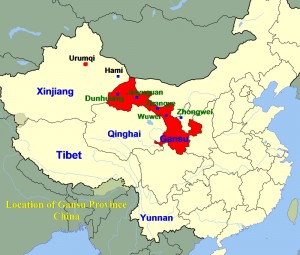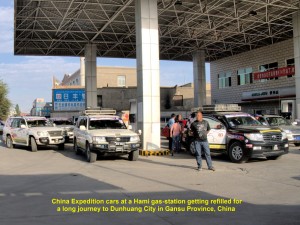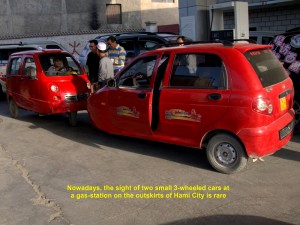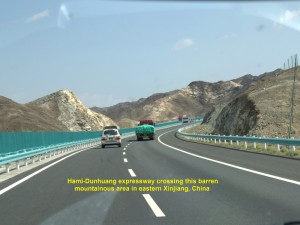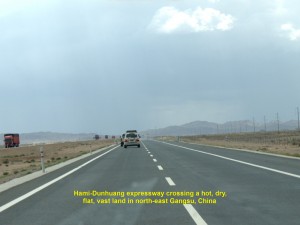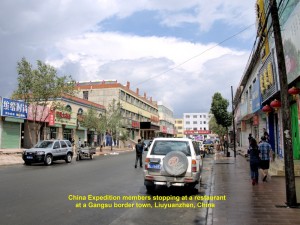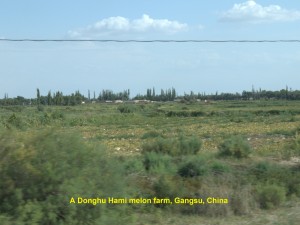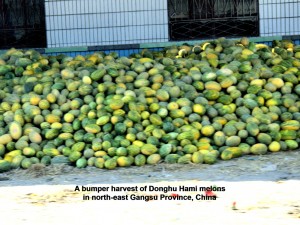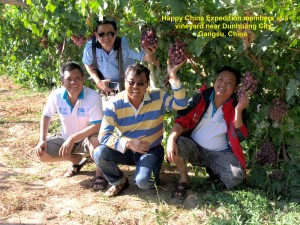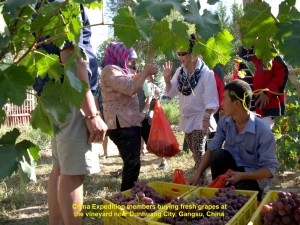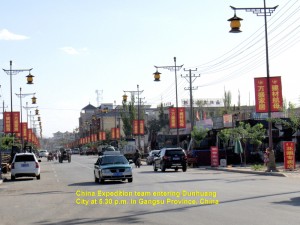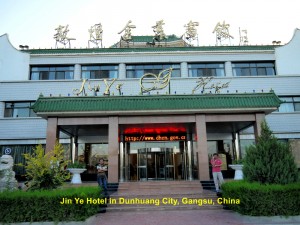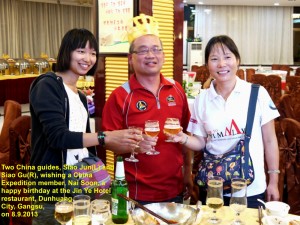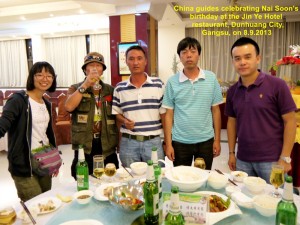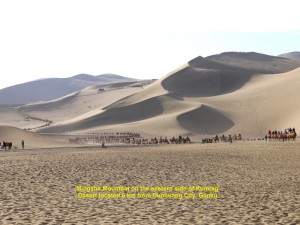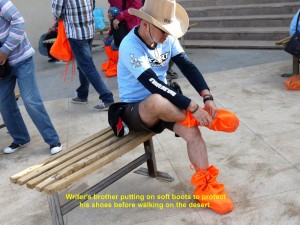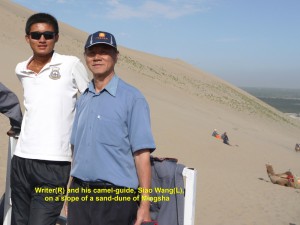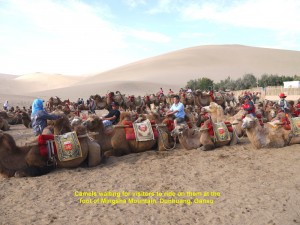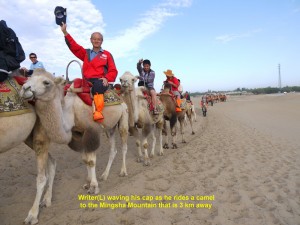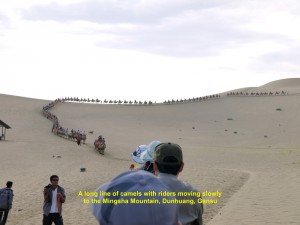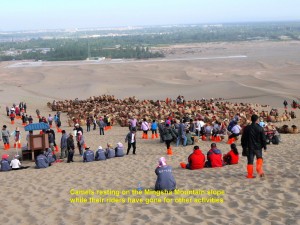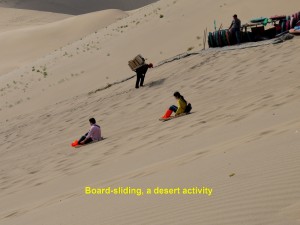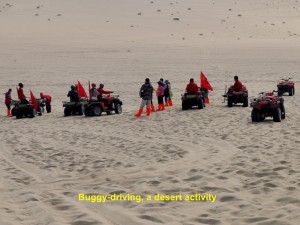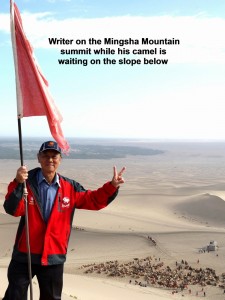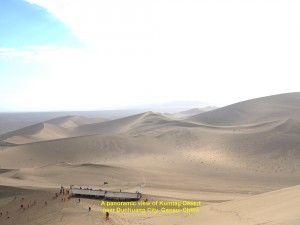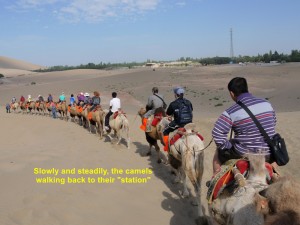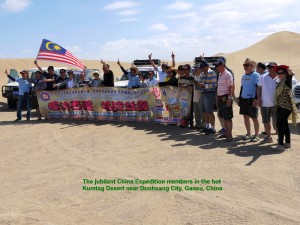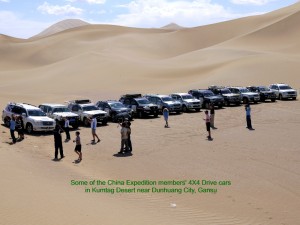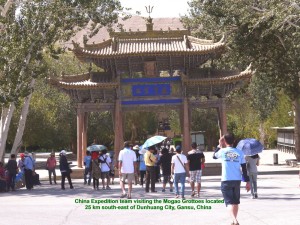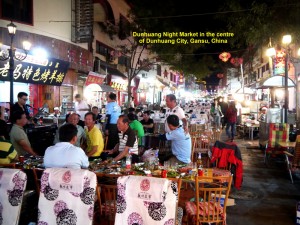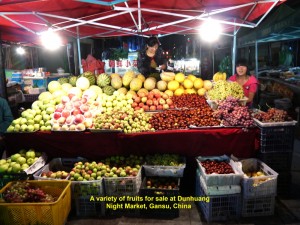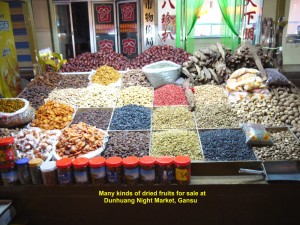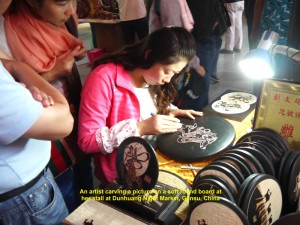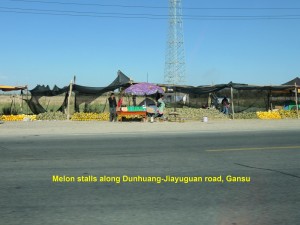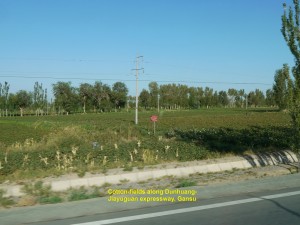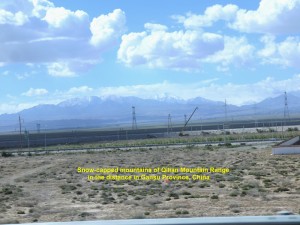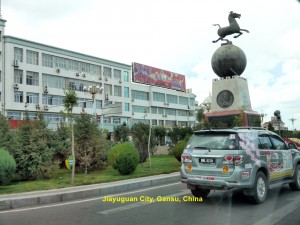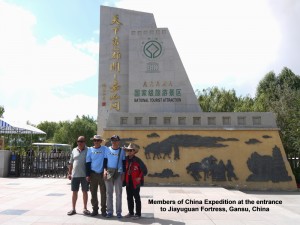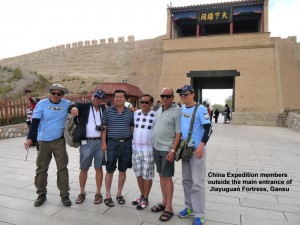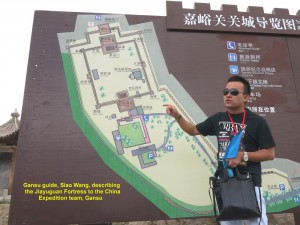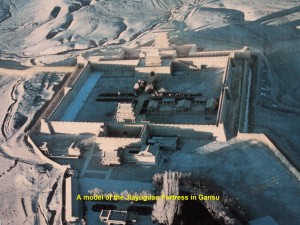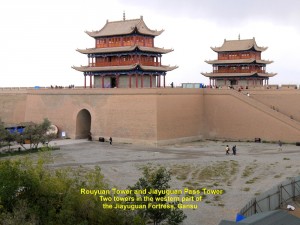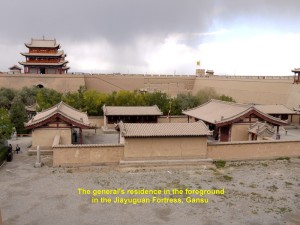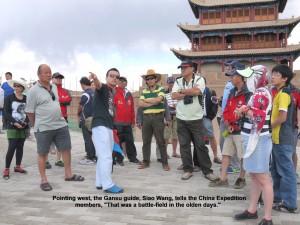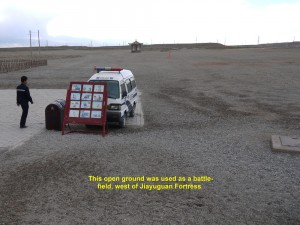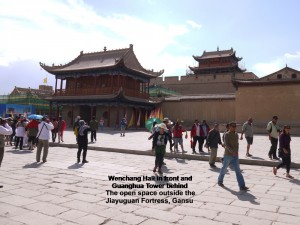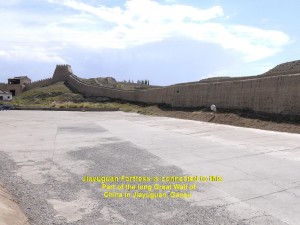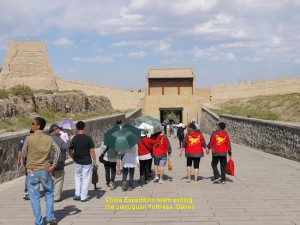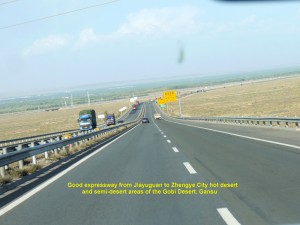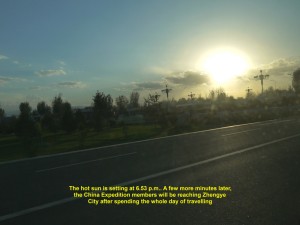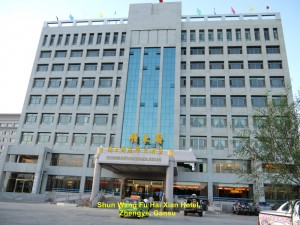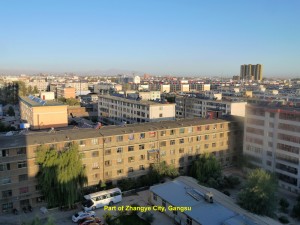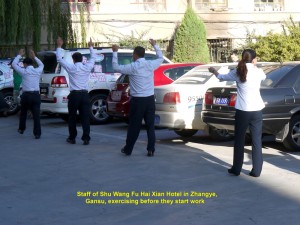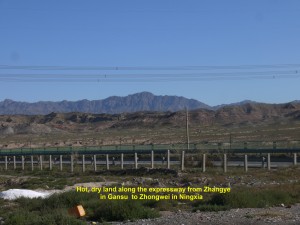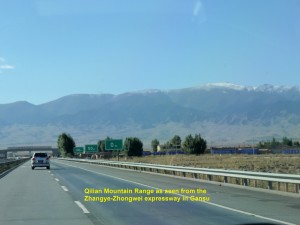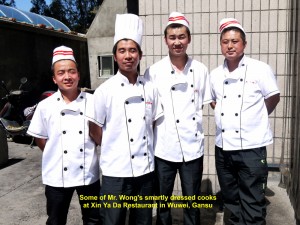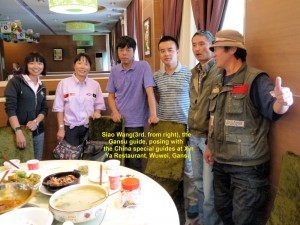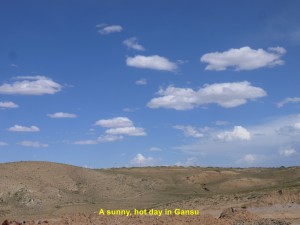Journal of My 2013 China Expedition Part VI (Gansu)
Journal of My 2013 China Expedition Part VI (Gansu)
Gansu Journey
Day 25 (Sunday, 8.9.2013)
Hami to Dunhuang
(Distance: 404 km)
At 9 in the morning we all left Jiageda Hotel in Hami City and went to a gas-station on its outskirts to refill our vehicles. Standing at the station we looked at the city in the distance for the last time, as were going to another city, Dunhuang in Gansu Province, about 404 km away. Then we were surprised to see two red small cars that had three wheels each came appeared at the gas-station. That was my first time seeing such a kind of vehicles.
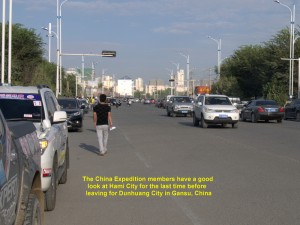
China Expedition members looking at Hami City for the last time before moving on to Dunhuang City in Gansu Province, China
Soon we were on our journey to Dunhuang City. At the beginning, we were crossing hot, dry, vast, flat land, barren mountainous areas, and then flat land again.
At 1.30 p.m. we stopped at a small restaurant for lunch at a small town, Liuyanzhen. An hour later, we were off again. Later, we were travelling across a fertile land where Donghu Hami melons and watermelons were grown, and then more fertile lands where cotton plants and grapevines were grown.
At 5 p.m., we stopped at a vineyard near Dunhuang City. Fortunately, the owner and his family were busy harvesting their large, juicy purple grapes. With the owner’s permission, we entered his vineyard. The moment we stepped in, we all felt delighted to see so many bunches of ripe grapes hanging from the vines. We were lucky to have come at the right time when the fruits ripened. Happily, all of us took several shots with the fruits. Before we left, many of us bought some of his grapes and ate them with joy.
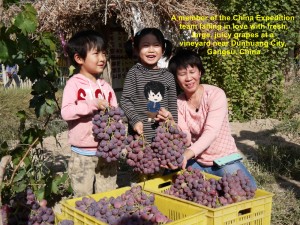
A China Expedition member has fallen in love with the large, juicy grapes at a vineyard near Dunhuang City, Gansu, China
At 5.30 p.m. we, finally, reached Dunhuang City and checked in at a hotel, Jin Ye Hotel.
At 7.30 in the evening, we had dinner at the hotel. While having dinner, we celebrated one of our member’s birthday, Tang Nai Soon. He was so happy that we all felt delighted. It should be a memorable celebration for him.
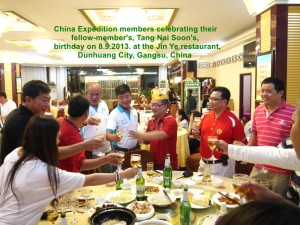
China Expedition members celebrating their fellow-member’s birthday on 8.9.2013 in Dunhuang City, Gansu
Day 26 (Monday, 9.9.2013)
Dunhuang in Gansu Province
At 8.20 in the morning we left Jin Ye Hotel and went to Mingsha Mountains which were actually high sand dunes in Kumtag Desert located 6 km south of Dunhuang City.
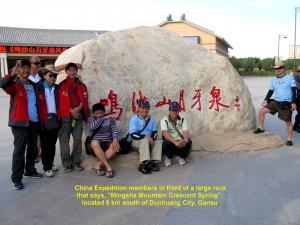
China Expedition members in front of a large rock that says “Mingsha Mountain Crescent Spring” located 6 km south of Dunhuang City, Gansu
On arrival we were amazed to see so many tourists going for camel ride. We bought tickets to ride the camels too. Before riding on them, we put on bright orange soft boots to protect our shoes.
Soon we were riding on the camels. I was in a group of six tourists each of us riding a camel. The camels were tied to each other with a rope and led by a camel-guide, Siao Wang, in front. Soon we were joining a long line of camels with riders that snaked its way in the direction of a high dune that was three km away.
Half an hour later, we reached a higher elevation on a sand-dune where we all alighted from the camels and were asked to go for other activities, e.g. board-sliding and buggy-driving, for a short while.
I climbed up to the summit of the Mingsha Mountain(a high sand-dune) and saw a panoramic view of the desert area which was breathtaking. Later, I sat on a circular tube and went down a steep slope of the dune for a short distance. That was an enjoyable activity which I had not done so for many years. The last time I slid down a slope was when I was on a snow-covered slope of Titlis Mountain in Switzerland in 2004.
Having spent over half an hour on the large sand-dune, Mingsha Mountain, we mounted the camels again and our camel-guide led the camels down the dune, slowly. That was my first, enjoyable and unforgettable experience.
At 12 noon we had lunch. After lunch we went to a spot in Kumtag Desert which was several kilometres from Dunhuang City. At that spot some of our car-owners showed off their skill at driving on sand dunes without getting their vehicles stuck in the sand. There were a few unlucky ones whose cars got stuck and had to be pulled out of the sand by other vehicles. We, the spectators, were enjoying our fellow-members’ brave desert actions.
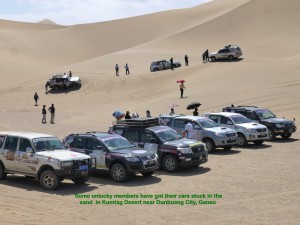
Two unlucky cars in the distance got stuck in the sand in the Kumtag Desert near Dunhuang City, Gansu
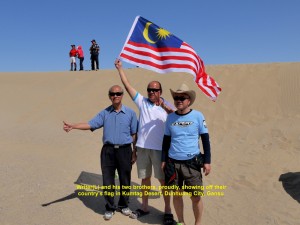
Writer(L) and his two brothers, proudly, showing off their country’s flag in the Kumtag Desert near Dunhuang City, Gansu
Later, we went to an ancient place that was 25 km south-east of Dunhuang City. Known as Mogao Grottoes, it has over 700 holes or “caves” dug out in the cliff of a hill between the 4th. and 14th. Century when the north silk route was the only overland road linking China in the east with regions in the west.
In the ancient times, there were many Buddhist scrolls, manuscripts, scriptures, statues, sculptures and murals in the “caves”. But now tourists could see repainted Buddhist murals and restored statues only in some of the”caves”. It was believed that treasure hunters had taken away many of those things in the last 100 years.
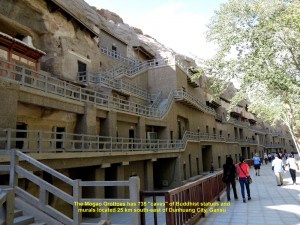
The Mogao Grottoes consisting of 735 “caves” containing Buddhist statues and murals near Dunhuang City, Gansu
When we arrived at the Mogao Grottoes, Miss Low, a guide, welcomed and brought us round to see some of the “caves”. There were four storeys of “caves” which were accessible by stair-cases. Miss Low brought us to the first two storeys and entered a few “caves” to see the murals and old Buddhist statues that were restored. We noticed that there were many “caves” in ruin and under lock. We spent about an hour and a half at that place before we left for our hotel in Dunhuang City.
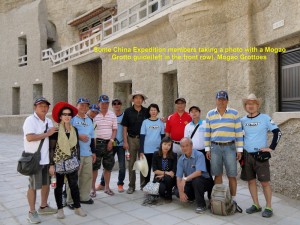
China Expedition members and a guide, Miss Low(squatting beside the writer), at the Mogao Grottoes, Dunhuang, Gansu
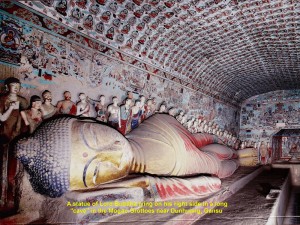
A statue of Lord Buddha lying on his right side in a long “cave” in the Mogao Grottoes, Dunhuang, Gansu
In the evening, we went to Dunhuang Night Market in the city-centre to have dinner at a eatery belonging to Uncle Salleh. Uncle Salleh, a friendly and happy Xinjiang man, had prepared a sumptuous dinner for us, members of the China Expedition. He served us grilled lamb and chickens, and a few kinds of salads. We thanked him for such good food that we had missed for the last over twenty days during our expedition.
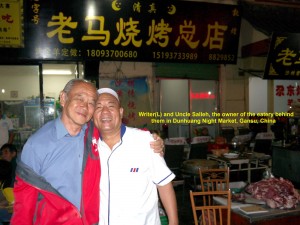
Writer(L) and Uncle Salleh, the proud owner of the eatery behind him at the Dunhuang Night Market, Gansu
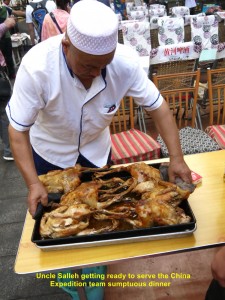
Uncle Salleh getting ready to serve the China Expedition members dinner at his eatery at Dunhuang Night Market, Gansu
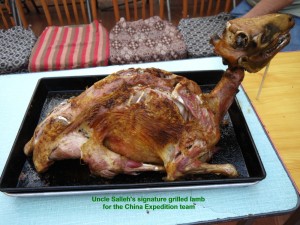
Uncle Salleh’s signature grilled lamb for the China Expedition members’ dinner at Dunhuang Night Market, Gansu
As we were enjoying the dinner we were entertained by a young local couple singing several popular Chinese songs. A few fellow-members, happily, joined in the singing.
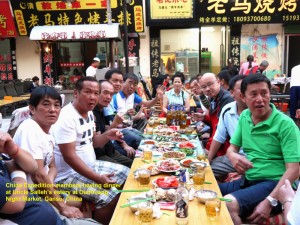
China Expedition members enjoying a sumptuous dinner at Uncle Salleh’s eatery at Dunhuang Night Market, Gansu
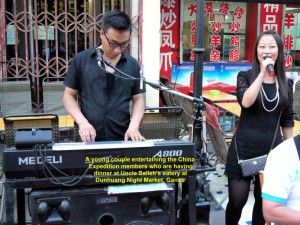
A young couple entertaining the China Expedition members who are having dinner at Dunhuang Night Market, Gansu
Before I went back to our hotel, I took a stroll to see many stalls selling handicrafts, clothes, foot-wear, fresh and dried fruits, etc. at the Dunhuang Night Market.
Day 27 (Tuesday, 10.9.2013)
Dunhuang – Zhengye
(Distance: 596 km)
At 8.45 a.m. we left Dunhuang City and travelled east to Zhengye City, a distance of 596 km away. On the way we came across cotton-fields and farms of sunflowers, barley and melons. But quite often we crossed hot, vast land in the Gobi Desert which was either semi-desert or desert with barren hills in the distance. After two hours of travelling, we saw a long mountain range, Qilian Mountain Range, with snow-capped mountains in the distance.
At 12.30 p.m. we arrived at Jiayuguan City where we met a young handsome Gansu guide, Siao Wang, and had lunch at a restaurant. Then we went to an ancient fortress which was 6 km away. It was known as Jiayuguan Fortress which was also a pass through the western Great Wall of China.
Built in 1372 in the Ming Dynasty to fend off invasion from the west, Jiayuguan Fortress has a wall in a shape of trapezium connected to the Great Wall of China. Within this wall is another wall that is higher and thicker, but square in shape. To make the fortress safer a moat was built outside the first wall.
The inner fortress has a gate in front in the east with a tall tower on top known as Guanghua Gate, and two gates at the back in the west with tall towers on their top known as Rouyuan Gate and Jiayuguan Pass Gate. In the middle of this fort is the general’s residence. The back of the fortress faces a vast open ground which was a battle-field.
While we were walking on the walkway on the fortress wall, a strong sandstorm from the desert in the west came and went, suddenly. We had to covered our faces, quickly, as we had no time to look for a place to hide.
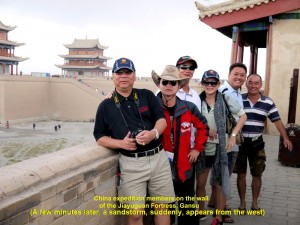
A sudden sandstorm occurs here while the China Expedition members are on the wall of the Jiayuguan Fortress, Gansu
After the interesting fortress tour, we walked back to our cars and continued our journey to Zhengye City at 4 p.m.. The expressway from Jiayuguan City to Zhengye City was good. It crossed hot desert and semi-desert areas of the Gobi Desert in Gansu. At 7 p.m. we finally arrived at Zhengye City where we had dinner and checked in at Shu Wang Fu Hai Xian Hotel in the centre of the city.
Day 28 (Wednesday, 11.9.2013)
Zhangye(Gansu) – Zhongwei(Ningxia)
(Distance: 570 km)
At 8 in the morning, some of our fellow-members, diligently, washed their cars clean in an open space near the hotel in Zhengye City. A few minutes later, a loud-speaker was playing a loud workout music and some hotel-workers appeared at the back of the hotel and began exercising. As I was watching them I felt I should join them in order to keep fit. Soon I was doing the workout with them for a short time. We had not done morning workout for quite sometime.
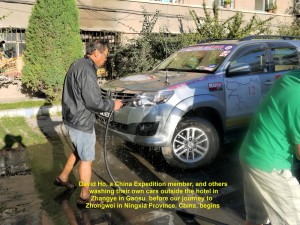
David Ho and other fellow-members of China Expedition, diligently, clean their own cars near the hotel in Zhangye City, Gansu
At 9 a.m. we left Zhangye City and travelled eastwards to Zhongwei City in another province, Ningxia, a distance of 570 km. It would be another long journey, and we always hoped that it would be another safe one like all the previous ones. The road to Zhongwei was good but lots of vehicles, small and large, were using it.
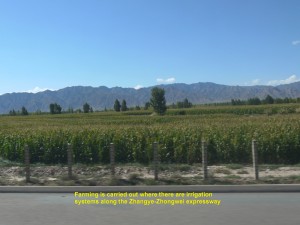
Farms are cultivated in areas where there are water irrigation systems along Zhangye-Zhongwei espressway, China
It crossed hot, dry lands and a few mountain ranges, e.g. Qilian Mountain Range, that could be seen in the distance from the road. Farms like barley, sunflowers, melons and corns were cultivated in some areas where water was available from irrigation systems or oases.
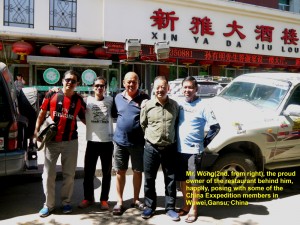
Mr. Wong(2nd. from right), the proud owner of the restaurant behind him, posing with some China Expedition members in Wuwei, China
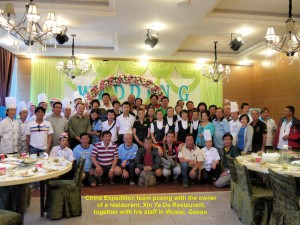
A group photo of Mr. Wong, his staff and members of the China Expedition team in Xin Ya Restaurant in Wuwei City, Gansu
At 12.30 p.m. we arrived at Wuwei City where we took our lunch at a restaurant, Xin Ya Restaurant. The owner of the restaurant, Mr. Wong, felt happy and honoured to have us from Malaysia and Singapore as his customers. After lunch, we all obliged him to have a group photograph taken with him and his staff. That was the first time a restaurant-owner in China requested us to do so and we were glad to do it.
Before we continued our journey to Zhongwei in Ningxia Province, we bid our Gansu-guide, Siao Wang, farewell. At 2 p.m. we left Wuwei City and travelled across hot, dry lands. The sky was blue with a few clouds all the time.
At 6 p.m. when we were near Zhongwei, we saw the Yellow River(Huang He) for the first time. It is China’s second longest river which is 5464 km long. Its source is in the Tibetan Plateau. When it reaches Gansu and Ningxia Provinces, it forms a loop known as “Ordos Loop”. It flows eastwards through 7 states in China before reaching the Gulf of Bohai.
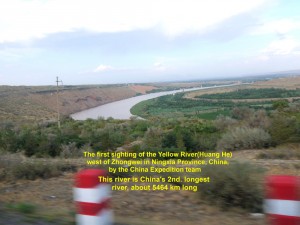
The first sighting of the Yellow River(Huang He) in Nimgxia Province, China by the China Expedition team
At 6.30 p.m. we, finally, reached Zhongwei City. We checked in at a hotel, Da Kong Hotel, first before we went to a restaurant nearby for dinner.
Journal of My 2013 China Expedition:
Written by Choo Chaw, Kluang, Johor, Malaysia
Comments
Tell me what you're thinking...
and oh, if you want a pic to show with your comment, go get a gravatar!

